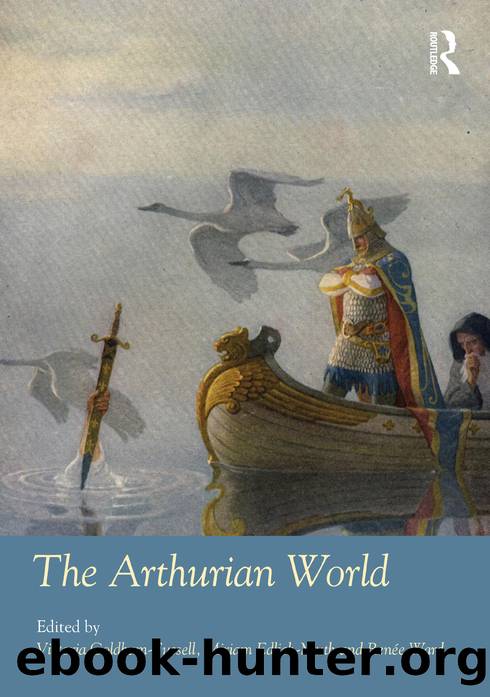The Arthurian World by unknow

Author:unknow
Language: eng
Format: epub
ISBN: 9780367172701
Publisher: TaylorFrancis
Published: 2022-05-25T00:00:00+00:00
Reception and canonization of the cycle
The impact of the Guiron cycle was immediate and enduring.7 Its protagonists had the greatest success, especially the members of the families of Guiron le Courtois and Galeholt le BrunâFébus le Fort, Hector le Brun, Branor le Brun, and othersâwho in the second half of the thirteen century had already become a new thematic focus of the Arthurian prose tradition. Northern Italy appears to have been the most receptive area (Cigni). It was here that, in the 1270s, new Arthurian texts would enjoy extensive success: the two compilations linked to Rustichello (Tuscany-Liguria) and the Prophéties de Merlin by the pseudo-Richard of Ireland (Prophecies of Merlin, Veneto). These texts draw on the Guiron cycle, and are, in turn, more or less directly implicated in the cyclification of the Guiron narratives, right up into the Cinquecento (Arioli, Ségurant ou le Chevalier au Dragon. Roman arthurien inédit and Ségurant ou le Chevalier au Dragon; Koble, âUn nouveau Ségurantâ and Les prophéties; Lagomarsini, Les aventures).
The stemmata provide a useful key to understanding how the textual network operated, as well as how it was spliced into the cultural sphere. Perhaps the most macroscopic case is that of the formation of the vulgate (the third cyclical form), which coincides with a wide-reaching reception hub, toward which flow the compilations linked to Rustichello and a branch of the tradition of the Prophéties. Geographically, its main axis connects northern Italy to France and Flanders, one of the liveliest networks in the spread of Italian culture in Europe. In the late Middle Ages, internationalization of this culture flourished and, during the Italian Wars, it took the form of a substantial flux of goods and works, Arthurian manuscripts included. From this perspective, the Guiron cycle was broader in circulation than subsequent Arthurian romances were: Ysaïe le Triste (Ysaïe the Sad), Perceforest, Artus de Bretagne (Artus of Bretagne), and the fifteenth-century mises en prose lacked a large manuscript dissemination and were brought back to life by the print tradition (Taylor).
The Italian reception during the thirteenth and fourteenth centuries is remarkable in the variety of its forms. One exceptional case is the Franco-Veneto epilogue of the Continuation of the Roman de Guiron transmitted only by manuscript X (first half of the fourteenth century): this is likely not a rewriting, but a text that was directly and intentionally conceived in that mixed language as part of a project which has still not yielded all of its secrets (Veneziale). A few decades earlier, the linguistic border had for the first time been crossed in manuscript 12599, an Arthurian miscellany which attests an Italian translation of a portion of the Roman de Guiron (Pisa-Lucca, end of the thirteenth century). This is the episode in which Bréhus, who has been knocked into a ditch by a cruel damsel, discovers by chance an underground mausoleum where Fébus le Fort and other forefathers of Guiron lie, and to which Guironâs father and other members of the family have withdrawn, living as hermits. Bréhus listens to their tales, and, together with the reader, becomes acquainted with the heroâs lineage.
Download
This site does not store any files on its server. We only index and link to content provided by other sites. Please contact the content providers to delete copyright contents if any and email us, we'll remove relevant links or contents immediately.
The Power of Myth by Joseph Campbell & Bill Moyers(1001)
Half Moon Bay by Jonathan Kellerman & Jesse Kellerman(952)
A Social History of the Media by Peter Burke & Peter Burke(935)
Inseparable by Emma Donoghue(921)
The Nets of Modernism: Henry James, Virginia Woolf, James Joyce, and Sigmund Freud by Maud Ellmann(833)
The Spike by Mark Humphries;(764)
The Complete Correspondence 1928-1940 by Theodor W. Adorno & Walter Benjamin(746)
A Theory of Narrative Drawing by Simon Grennan(742)
Culture by Terry Eagleton(712)
Ideology by Eagleton Terry;(696)
Bodies from the Library 3 by Tony Medawar(680)
World Philology by(673)
Farnsworth's Classical English Rhetoric by Ward Farnsworth(672)
Game of Thrones and Philosophy by William Irwin(669)
High Albania by M. Edith Durham(654)
Adam Smith by Jonathan Conlin(648)
A Reader’s Companion to J. D. Salinger’s The Catcher in the Rye by Peter Beidler(646)
Comic Genius: Portraits of Funny People by(616)
Monkey King by Wu Cheng'en(609)
